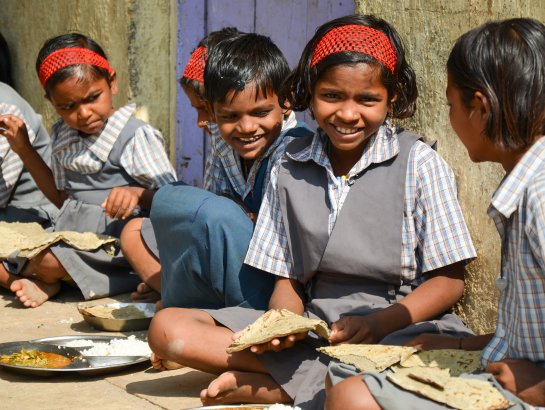A new study has found that pearl millet bred to be richer in iron was able to reverse iron deficiency in school-aged Indian children in six months. In just four months, iron levels improved significantly.
Previously, the same iron-rich pearl millet had been shown to provide iron-deficient Indian children under the age of three with enough iron to meet their daily needs, and adult women in Benin with more than 70 percent of their daily needs.
Lack of iron impairs cognitive development and behavior in children, and adults’ ability to work. Severe anemia, often caused by iron deficiency, increases risks to women in childbirth, including death. Despite efforts to curb iron deficiency through supplements and fortified foods, iron deficiency remains the most widespread nutrition deficiency in the world, affecting 1.6 billion people.
Biofortification is a novel approach pioneered by HarvestPlus, a global program to improve nutrition that helps close the deficiency gap by conventionally breeding food crops that are naturally higher in key vitamins and minerals.
Pearl millet is eaten daily by more than 50 million people in the semi-arid regions of India and by millions of people in Sahelian Africa. The iron-rich pearl millet variety used in this study was developed in partnership with the International Crops Research Institute for the Semi-Arid Tropics (ICRISAT) in India.
In this study just published, school children aged 12 to 16 years, and many of whom were iron deficient, ate iron-rich pearl millet in the form of bhakri (a flat, unleavened bread) at midday and evening meals. Eating iron-rich pearl millet significantly improved their iron status in four months, compared with ordinary pearl millet. Those children who were iron deficient at the start and ate iron-rich pearl millet bhakri were 1.6 times more likely to have resolved their iron deficiency compared with those who ate bhakri made from the ordinary pearl millet.
According to Dr. Jere Haas, the Nancy Schlegel Meinig Professor of Maternal and Child Nutrition in the Division of Nutritional Sciences at Cornell University, who led the study, “More than 40 percent of these school-aged children were iron deficient at the start of our study. We now have clear evidence that feeding iron-biofortified pearl millet to improve iron status in secondary school-age children works.”
Dr. Erick Boy, Head of Nutrition at HarvestPlus, says, “This is the first study that shows that a food naturally rich in iron can reverse iron deficiency in such a short period of time. The amount of iron naturally provided in the food was similar to iron supplements, so these results are comparable to supplements, and better than iron-fortified flours.”
These results are consistent with a previous efficacy trial also funded by HarvestPlus in the Philippines in which iron levels improved for women who ate iron-rich rice.
The iron-rich pearl millet variety used in this study, ICTP-8203Fe, is commonly known as Dhanashakti, which means prosperity and strength, and was commercialized in 2012 in Maharashtra, India, by HarvestPlus partner Nirmal Seeds. Tens of thousands of farmers have planted this new iron-rich variety that also provides more zinc, is high yielding, and disease and drought tolerant.
Related Journal Articles
All articles are made available as free open access by HarvestPlus
Biofortification of Pearl Millet with Iron and Zinc in a Randomized Controlled Trial Increases Absorption of These Minerals above Physiologic Requirements in Young Children
More About Pearl Millet
Pearl millet is a hardy warm-season, dryland cereal grain crop largely grown in the drought-prone regions of Africa and Asia where it performs better than other cereals. Originating in the Sahelian zone of western Africa about 5,000 years ago, pearl millet was introduced in India about 3,000 years ago, and in southern and eastern Africa about 2,000 years ago. It is an important staple food in the drier regions of Sub-Saharan Africa, especially in Nigeria, Niger, Mali, and Burkina Faso. In India, about 50 million people mostly in the states of Rajasthan, Maharashtra, Gujarat, Haryana, and Uttar Pradesh rely upon pearl millet as a staple food. Its tolerance to drought, heat, and soil salinity, and its high water-use efficiency makes it a climate-smart crop. In addition, given its high protein and mineral content, high dietary fiber, and gluten-free protein, the area under pearl millet cultivation is expected to increase in the future.
